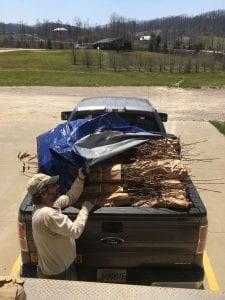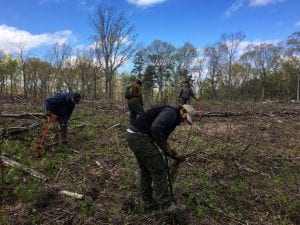In April of 2018 the Georgia Department of Natural Resources, along with the American Chestnut Foundation, broke ground on a project that has been years in the making. Two small crews lead by Nathan Weaver, the GADNR forester for north Georgia, planted approximately 2,500 American chestnut B3F3 hybrid seedlings at Dawson Forest Wildlife Management Area. Volunteers from within GADNR, the public, The Nature Conservancy, and Wildland Restoration International Assisted with the project. Bare root seedlings were provided by state nurseries in West Virginia and Kentucky.

Hybrid seedlings loaded up just before being covered with ice and tarps for the trip to their new home in Georgia.
The plantings will be part of a long-term research project on fire tolerance and silvicultural viability of the chestnut hybrids. The project is a collaboration between GADNR, Berry College, and The American Chestnut Foundation. The goal is for the Georgia Department of Natural Resources to provide technical guidance on wildland plantings of the hybrids to Georgia landowners. Traditional orchard planting may not be cost effective for some landowners who want the species established on their property, as there may be no power for electrical fencing and it can be expensive or impractical to use traditional nursery techniques like mowing and tubes. We want to demonstrate an economically viable process for a landowner who is interested in conservation, as well as timber revenue. Pine tree value has proven to be somewhat volatile in north Georgia, while hardwood markets have remained consistent and strong over the past few decades. In north Georgia hardwood is and likely will remain higher in market value.

Volunteers Jen Houts (The Nature Conservancy), Ryan Kennelly, Joey Bell, and Ethan Daley (Wildland Restoration International) planting seedlings at Dawson Forest WMA.
The second piece of the study will involve learning about the fire tolerance of the hybrids. It is presumed that it is a fire tolerant species, and some recent work by other groups is confirming this. Our goal is to produce recommendations for landowners on how long to wait before performing the first prescribed burn to ensure maximum survival. Each block will be broken into 4 sub-units, that will be burned after three years, six years, eight years, or not at all. We are interested in seeing if the hybrids can be managed in conjunction with shortleaf pine, as the two species prefer dryer and rockier soil.
About 3 months after planting we are seeing 80-85% survival of seedlings, with little to no evidence of browse from deer (*knocks on wood*). Some insect herbivory has occurred. We will continue to monitor the trees, keeping track of survival rates.

Volunteers Cody Venters, Kiki Dehondt, Jen Houts (TNC), and Nick Batt planting trees at Dawson Forest WMA.

